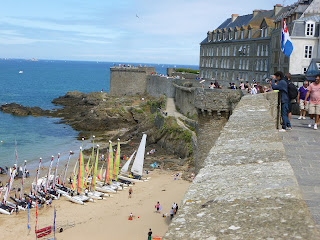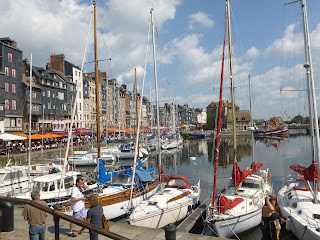 |
| The town of Dinard has several beautiful beaches |
 |
| Beach tents in Dinard |
 |
| Our 'villa' was in the white building, 2nd from right |
 |
| Villas atop Dinard's cliff overlooking the coastal walkway |
 |
| View from our terrace |
 |
| St. Malo |
 |
| The ramparts surrounding the city of St. Malo |
Directly across the water from Dinard is the medieval, walled city of St. Malo. We boarded the water taxi from a dock right below our window for the short ride over. Built in the 12th century as a walled citadel at the mouth of the Rance River, it was once the home of feared pirates as well as the birthplace of Jacques Cartier who explored Canada, claimed much of it for France and gave the country its name. Today St. Malo is Brittany's most visited destination.

 After Dinard, we traveled up the coast to Perros-Guirrec, named after a saint who came here from Wales in the 7th century. It is renowned for its place on the 18 mile Pink Granite Coast. We followed the walking path from one part of town to another for about 3 miles, fascinated by the various rock formations carved over thousands of years by wind and waves. This particular type of rock is found in only two other places in the world - Corsica and China.
After Dinard, we traveled up the coast to Perros-Guirrec, named after a saint who came here from Wales in the 7th century. It is renowned for its place on the 18 mile Pink Granite Coast. We followed the walking path from one part of town to another for about 3 miles, fascinated by the various rock formations carved over thousands of years by wind and waves. This particular type of rock is found in only two other places in the world - Corsica and China.  |
| Roscoff |
 |
| Boarding the tourist train for a ride around Roscoff |
Roscoff, our next stop, was one of the cutest towns we have visited. It is renowned for its beautiful 16th century homes, colorful fishing boats in the harbor, and uniquely flavorful onions. It proudly bears the title "Small town of character."
 |
| Roscoff has rich seaweed beds |
 |
| Various types of dried seaweed |
 |
| Finister: Crozon Peninsula |
Brittany has a unique flavor and we greatly enjoyed our time here. Now we will follow the French coast south along the Atlantic Ocean.











